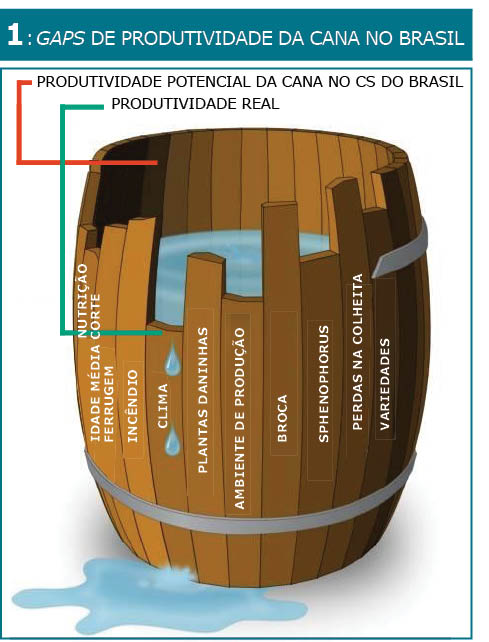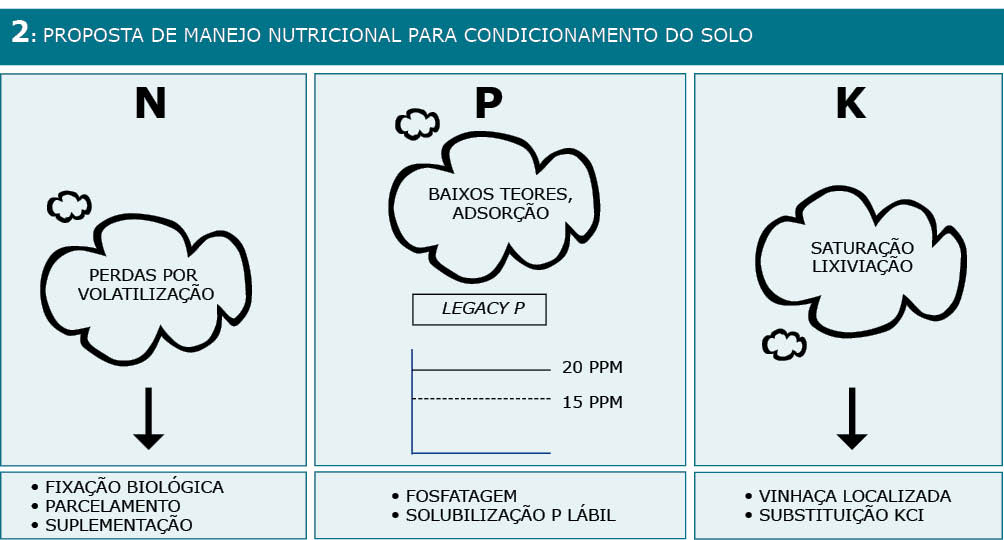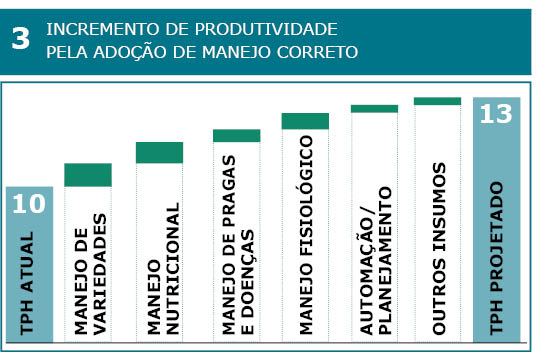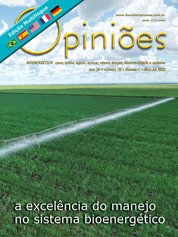René de Assis Sordi
Consultor em Tecnologia Agronômica na Enercana
OpAA76
Manejos para aumentar a produtividade da cana-de-açúcar
Temos passado por um momento de transição na produtividade da cana-de-açúcar no Centro-Sul do Brasil. Percebe-se que muitas usinas e produtores têm consolidado recentemente rendimentos crescentes anualmente, depois de preocupante declínio e de uma década de paralisação, em que a produção média por área ficou em torno de 70 a 75 toneladas de colmos por hectare (TCH) e os níveis de ATR, de 128 a 134 Kg/t de cana.
São vários os motivos que ocasionaram essa estagnação:
• clima desfavorável em vários anos subsequentes, com veranicos mais intenso e secas prolongadas;
• adaptação à mecanização, com aumento das perdas e das impurezas vegetais na colheita e falhas e elevado consumo de mudas no plantio;
• expansão para ambientes edafoclimáticos desfavoráveis;
• alongamento do período de moagem, antecipando o início para o outono e postergando o final para dezembro, em ambos os períodos os teores de sacarose são menores, sendo que a produtividade de colmos das canas colhidas em dezembro invariavelmente é menor na safra seguinte;
• envelhecimento do canavial, aumentando a idade média, com redução da porcentagem de renovação e plantio;
• pouca renovação do plantel varietal;
• aumento de pragas e doenças, entre outros.
 A figura 1, ilustra pontualmente os gaps de produtividade da cana-de-açúcar no Centro-Sul do Brasil. Entre esses diversos fatores bióticos e abióticos, sem dúvida podemos elencar o clima – englobando principalmente a seca, mas também geada e florescimento –, como o mais impactante. Tem sido grande o dano causado por pragas, dentre elas o sphenophorus levis e a ocorrência de plantas daninhas como a grama-seda, entre outras; mas também são significativos os prejuízos causados por manejos inadequados.
A figura 1, ilustra pontualmente os gaps de produtividade da cana-de-açúcar no Centro-Sul do Brasil. Entre esses diversos fatores bióticos e abióticos, sem dúvida podemos elencar o clima – englobando principalmente a seca, mas também geada e florescimento –, como o mais impactante. Tem sido grande o dano causado por pragas, dentre elas o sphenophorus levis e a ocorrência de plantas daninhas como a grama-seda, entre outras; mas também são significativos os prejuízos causados por manejos inadequados.Mas o que de fato é o manejo agrícola? Ele pode ser definido como a ação dos técnicos e produtores em promover modificação, adequação e interferência nos diversos processos agrícolas; influenciando a produção. Nesse conceito, os manejos adequados ou corretos podem consequentemente colaborar para o aumento da produtividade.
O Manejo Varietal poderia ser o primeiro item a ser discutido. Do elenco disponível, saber em que tipo de solo tais variedades devem ser cultivadas (pelas exigências em fertilidade e disponibilidade hídrica inerente a cada uma delas) e qual o período de safra a serem colhidas (pelas suas características de maturação precoce, média ou tardia) é fundamento básico na área agronômica.
Nesse quesito se enquadram também algumas outras ferramentas como o uso de maturadores químicos e/ou fisiológicos, visando
antecipar a maturação das variedades no início da safra, o que pode gerar um aumento proporcional no ATR médio final e o uso de inibidores de florescimento em anos favoráveis, ou mesmo visando aumentar o PUI de algumas variedades.
Estrategicamente temos também o manejo das fases cronológicas e fisiológicas do canavial, consistindo no planejamento de colheita de maneira a aumentar a idade (em meses) das canas colhidas, trazendo um impacto notório no aumento de TCH e ATR; assim como a destinação de colheita dos piores ambientes para o início e meio da safra.
O próximo item seria o Manejo Nutricional. Houve uma mudança recente na abordagem desse assunto, passou-se a usar a adubação não só pensando em a repor o extraído pela cana; mas também em fazer um "condicionamento do solo" de maneira a racionalizar o aproveitamento dos nutrientes e formar um estoque dos mesmos.
A figura 2 mostra de forma esquemática que podemos manejar melhor o N usando o parcelamento da adubação na soca, assim como a suplementação de dose via aérea a partir do início do verão no boom de desenvolvimento vegetativo e produtos para aumentar a fixação biológica.

Quanto ao K, um grande avanço foi a implementação na soca da aplicação localizada de vinhaça, quer seja in natura ou concentrada, adicionada ou não a outros insumos como inseticidas, promotores de crescimento e produtos biológicos.
Acreditamos que essa modalidade de aplicação é uma ferramenta que melhora muito a qualidade da operação, agregando outros benefícios como a expansão da área aplicada, a diminuição das perdas por lixiviação e até mesmo a diminuição da proliferação da mosca dos estábulos.
Mas, aparentemente, é no P que teremos grandes impactos de um manejo adequado, quando aumentarmos a sua disponibilidade, compensando a adsorção (Legacy P) inerente dos nossos solos.
A elevação desses teores de P2O5 nos nossos solos para níveis superiores a 15ppm, quer seja através do uso de solubilizadores, ou com a fosfatagem corretiva por meio do uso de fertilizantes fosfatados ou rochas naturais; esse é um dos exemplos que ocorreu na área de grãos que devemos seguir agora também na cana.
Outra importante prática é o Manejo de Pragas e Doenças. O conceito de MIP – Manejo Integrado de Pragas – se consolidou no setor, associando o uso de agentes biológicos, como as vespinhas cotesia e trichogramma (atualmente liberados na lavoura via drones) ao fungo beauveria e a inseticidas para o controle da broca.
Aliás, o uso de agentes biológicos tem aumentado muito no setor, e tem se tornado um campo que vai muito ao encontro dos valores de sustentabilidade e ESG. No controle de doenças, tem havido também uma mudança significativa de abordagem, quando se passa a usar fungicidas em pulverizações aéreas para controle de ferrugens, num manejo que proporciona uma maior área foliar fotossinteticamente ativa, pela limpeza inclusive de outras doenças foliares secundárias.
 Tais fungicidas sistêmicos, como benzimidazois, triazois e estrobilurinas, proporcionam adicionalmente o conhecido efeito fitotônico de aumentar a produtividade, enquandrando-se no que podemos chamar de Manejo Fisiológico.
Tais fungicidas sistêmicos, como benzimidazois, triazois e estrobilurinas, proporcionam adicionalmente o conhecido efeito fitotônico de aumentar a produtividade, enquandrando-se no que podemos chamar de Manejo Fisiológico. Nessa modalidade pode ser citado o uso de ácidos húmicos e fúlvicos, promotores de crescimento e de enraizamento, fungos e bactérias solubilizadores de N e de P, e uma grande gama de novos agentes que atuam na fisiologia e processos metabólicos da planta, numa interação interessante que pode proporcionar uma mitigação de efeitos de estresse hídrico e nutricional.
Concluindo nossa opinião, na figura 3 sugerimos a magnitude que cada um dos manejos adequados discutidos pode potencialmente proporcionar em aumento de produtividade nos nossos canaviais.
Inserimos também outras ferramentas, como a automação e uso de novos produtos e insumos. Notem que, nessa estimativa, na média é possível passar, em pouco tempo, de um nível atual de cerca de 10 para 13 toneladas de açúcar por hectare.
Difícil, mas não impossível. Já existem algumas usinas e produtores com essas marcas.
“Quem viver verá.”




